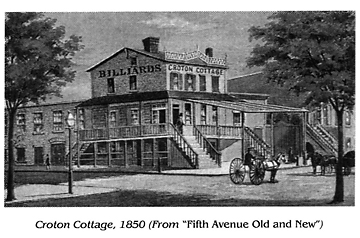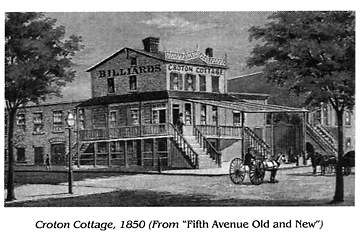

The charming edifice pictured here was Croton Cottage, at Fifth Ave. and 40th St. in Manhattan. The illustration is from the 1924 book, Fifth Avenue Old and New 1824-1924 by Henry Collins Brown, written for the Fifth Avenue Association. The book states:
"In the years following the opening of the Aqueduct it was made the end of the afternoon drive from St. John's Park, Second Avenue and other fashionable sections, and Croton Cottage provided ice cream and other refreshments. It also had a curious 'maze' in its garden which greatly interested the country visitor. It was destroyed by fire during the draft riots..."
Last year the Croton Reservoir Tavern was opened in midtown at 108 West 40th Croton Cottage, 1850 (From "Fifth Avenue Old and New") St., between Broadway and Sixth Ave., by a restaurateur who is a New York history buff. The restaurant is about a block from where the Old Croton Aqueduct's distributing reservoir stood from 1842 to 1899. The reservoir is pictured on a large wall mural just inside the restaurant entrance and on its business cards. Quoting from the Brown's book:
"The Old Croton Aqueduct [reservoir)- the most famous Metropolitan structure of its time-extended from 40th to 42d Street, on the land now occupied by the imposing building of the New York Public Library.
"The year 1842 marked what was perhaps the greatest forward stride in the city's history-the general introduction of running water . . . that stupendous improvement . . . When the reservoir was first completed it had a spacious promenade all around the top of the walls upon which gay and animated groups constantly gathered. Old letters speak of the delightful scene at night, with the moonlight dancing on the water. In the daytime, charming views of Long island, the distant hills of Westchester, and the lordly heights of the Palisades provided a fascinating panorama. . . ."
Barbara McManus of the Hastings Historical Society notes that Henry CollinS Brown lived in Hastings and was one of the founders of the Museum of the City of New York.

